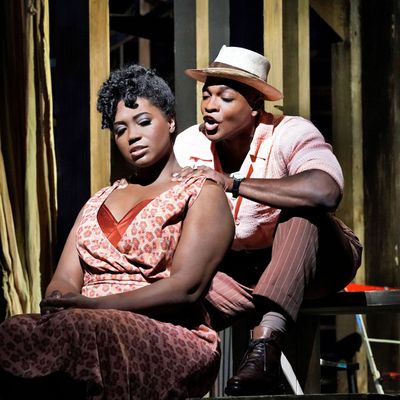
The longest-running, dumbest debate in musical categorization got an answer at the Met’s season-opening night: Porgy and Bess is neither a musical nor an opera; it’s two operas. One is a profound and moving portrait of neighborhood pummeled by deprivation, racism, and hurricanes. The other is a pageant of mortifying stereotypes: the flashy drug dealer, the promiscuous addict, the panhandler with a platinum soul, the army of Lord-praising church ladies waving their hands at the sky. What binds those irreconcilable differences into an abiding piece of theater is George Gershwin’s music, which has more marvels per yard than much of the standard repertoire. And, in its first revival in a generation, the Met does the score proud.
Even though Porgy’s been gone from the house since 1990, the company treated it as utterly familiar territory. David Robertson has the Met’s orchestra whipping up Verdian gales and caressing Puccini-esque arias. Bass-baritone Eric Owens lends hard-earned Wagnerian majesty to the title role. Alfred Walker, a veteran of 150 Met performances over two decades, draws on a deep well of operatic villains for his terrifying portrayal of Crown. And Latonia Moore, who has sung a scorching Aida at the Met, delivers Serena’s aria, “My Man’s Gone Now,” with the kind of confidence that comes from playing a princess on the world’s most intimidating stage.
Gershwin conceived Porgy and Bess in part as a stepping-stone for struggling black singers. He would have been gratified to see this production reap the benefits of so many rich careers. On opening night, the competition for the most raucous ovations was intense, and not limited to top-billed artists. Leah Hawkins, a member of the Met’s young artist program, turned the Strawberry Woman’s cry into a two-minute revelation.
All those musical superpowers on the Met’s stage make Porgy as easy to love as it is hard to swallow. Director James Robinson makes no excuses for the written-out patois. ( “Them’s the same cock-eyed bones what clean the game out last Saturday night. If they rolls in this game, I rolls out.”) He doesn’t try to humanize the “drinkin’, gamblin’, swearin’ ” — not to mention murdering, beating, and raping — Crown, or soften the scene in which Bess throws herself into her abuser’s arms. This is not a Porgy for the Black Lives Matter or #MeToo eras. It’s the same old troubled triumph, flaunting the same old faults and doing so magnificently. Catherine Zuber dresses the downtrodden in stylish misery and set designer Michael Yeargan turns Catfish Row into a rotating cluster of fishermen’s stilt houses. Porgy takes Bess as she is, not as he would like her to be, and we must do the same for the work. Opera audiences will tolerate a lot of clichés in exchange for some mighty singing.
Music is like a drug, and its narcotic powers have made it a struggle for the Met to drag itself into the present. Give it points for trying. True, the only depiction of African-American life that makes it to the opera stage with any regularity was written by three white guys, but the Met has the beginnings of an alternative: Just before launching the season, the company announced plans to stage Terence Blanchard’s Fire Shut Up in My Bones, based on a memoir by the Times columnist Charles Blow.
In the meantime, this Porgy depends on a cast whose members not only sing superbly but sing to each other. As the curtain goes up, Clara soothes her newborn with “Summertime,” and Golda Schultz really does seem to be blessing the doll in her arms with all the pleasurable memories she can muster from a difficult life. Frederick Ballentine does more than strut and ooze as Sportin’ Life; he understands Bess enough to manipulate her.
And at the heart of the show are Owens and the soprano Angel Blue, who made the title characters’ love utterly believable, never something to be taken for granted in opera. Owens sings with urgent reticence, letting his big voice roll through the lines like deep waves. Porgy has learned that, without the full command of his body, he must tame his emotions, and the tension between passion and control plays out in his voice. Instead of kneeling or pushing himself around on a wooden cart, Owens stands with his leg in a brace, using his crutch as support, weapon, and expressive tool. That simple decision to get Porgy off the floor allows Owens to deploy the full measure of his stage presence — and, incidentally, compensate for the moments when the part drifts a little high for comfort.
Blue, too, finds a way to dose tenderness and vulnerability into an almost three-dimensional Bess. Whether she’s sashaying into Catfish Row or flopping in a drugged stupor, she wears a bruised soul and sings with polished radiance. But it’s the fusion of her and Owens’s dark timbres and emotional currents that bears the opera’s tragic load. When Porgy limps off to follow the runaway Bess to New York, we root for a reunion, mostly because we want to hear their voices intertwine once more.
*A version of this article appears in the September 30, 2019, issue of New York Magazine. Subscribe Now!


